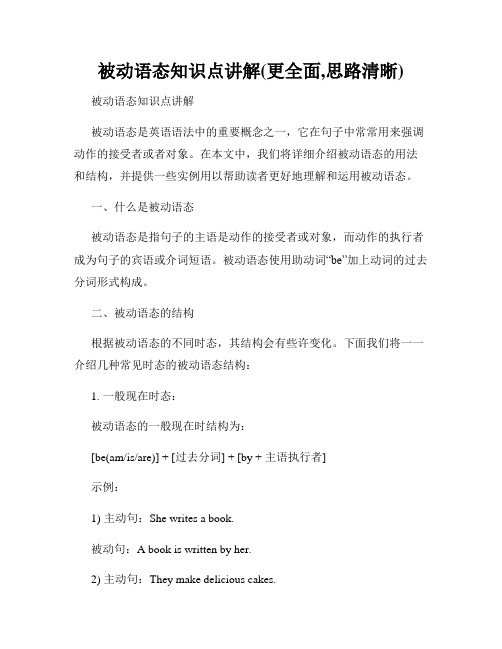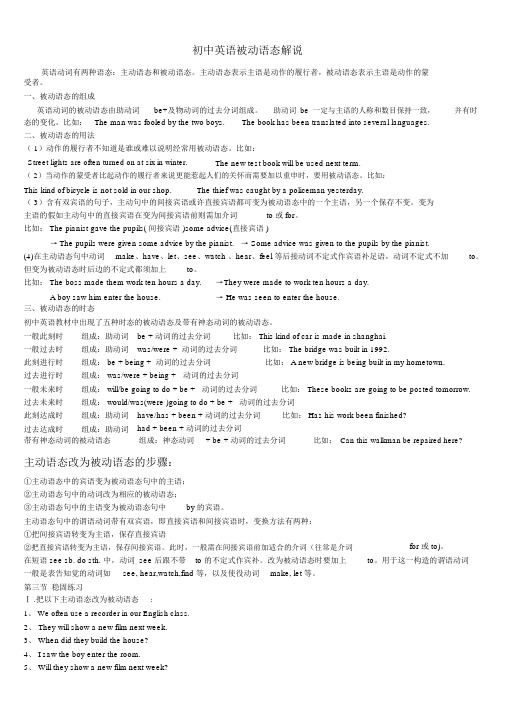初中英语语法被动语态(精讲)
被动语态知识点讲解(更全面,思路清晰)

被动语态知识点讲解(更全面,思路清晰)被动语态知识点讲解被动语态是英语语法中的重要概念之一,它在句子中常常用来强调动作的接受者或者对象。
在本文中,我们将详细介绍被动语态的用法和结构,并提供一些实例用以帮助读者更好地理解和运用被动语态。
一、什么是被动语态被动语态是指句子的主语是动作的接受者或对象,而动作的执行者成为句子的宾语或介词短语。
被动语态使用助动词“be”加上动词的过去分词形式构成。
二、被动语态的结构根据被动语态的不同时态,其结构会有些许变化。
下面我们将一一介绍几种常见时态的被动语态结构:1. 一般现在时态:被动语态的一般现在时结构为:[be(am/is/are)] + [过去分词] + [by + 主语执行者]示例:1) 主动句:She writes a book.被动句:A book is written by her.2) 主动句:They make delicious cakes.被动句:Delicious cakes are made by them.2. 现在进行时态:被动语态的现在进行时结构为:[be(am/is/are)] + [being] + [过去分词] + [by + 主语执行者]示例:1) 主动句:He is washing the car.被动句:The car is being washed by him.2) 主动句:They are building a house.被动句:A house is being built by them.3. 一般过去时态:被动语态的一般过去时结构为:[be(was/were)] + [过去分词] + [by + 主语执行者]示例:1) 主动句:She bought a new car.被动句:A new car was bought by her.2) 主动句:They painted the wall.被动句:The wall was painted by them.4. 过去进行时态:被动语态的过去进行时结构为:[be(was/were)] + [being] + [过去分词] + [by + 主语执行者]示例:1) 主动句:He was cleaning the house.被动句:The house was being cleaned by him.2) 主动句:They were repairing the car.被动句:The car was being repaired by them.三、被动语态的用法被动语态的使用可以有多种情况,下面是几个常见的用法:1. 强调行为的接受者:被动语态可以强调动作的接受者或者对象,使其在句子中得到突出。
初中英语语法——被动语态用法总结归纳

初中英语语法——被动语态用法总结归纳被动语态是英语语法中的重要部分,学好被动语态的用法可以帮助学生更准确地理解和使用英语。
下面是被动语态用法的详细总结归纳。
1.被动语态的构成:被动语态由“助动词be+过去分词”构成,根据时态的不同,助动词be的形式也会发生变化。
如:- 一般现在时:am/is/are + 过去分词- 一般过去时:was/were + 过去分词- 一般将来时:will be + 过去分词- 现在进行时:am/is/are being + 过去分词- 过去进行时:was/were being + 过去分词- 现在完成时:have/has been + 过去分词- 过去完成时:had been + 过去分词2.被动语态的用法:被动语态用来强调动作的承受者(主语)而不是执行者,并且常用于以下情景:2.1当我们不知道或不关心动作的执行者时。
例如:The cake was eaten.(蛋糕被吃了。
)2.2当动作的执行者已知,但我们要强调动作的承受者时。
例如:The house was built by my grandfather.(这座房子是我爷爷建的。
)2.3当我们要避免使用第一人称或第二人称时。
例如:Mistakes were made.(犯了错误。
)3.被动语态的注意事项:在使用被动语态时,需要注意以下几点:3.1表示动作的动词要用过去分词形式。
过去分词的形式有规律变化和不规律变化两种。
如:- 规律变化:原形 + ed,例如:played, watched, called- 不规律变化:需要记忆,例如:born, written, eaten3.2被动句的主语是动作的承受者,通常出现在句子的前面。
如:- 主动语态:I cooked dinner.(我做了晚饭。
)- 被动语态:Dinner was cooked by me.(晚饭是我做的。
)3.3 不及物动词不能构成被动语态。
不及物动词没有宾语,因此不能强调动作的承受者。
被动语态(15张PPT)初中英语专项复习课件

主动语态变被动语态的方法
英语的谓语动词有两种状态
We 主语
speak 谓语
English. 宾语
English 主语
is spoken 谓语
by us. 宾语
主动语态变被动语态的方法
主动结构:
1 The people always open the
window.
被动结构:
1 The window is always opened by
3 主动: see sb do
被动: sb be heard to do
Lucy was heard to sing in the classroom by me.
被动: sb be seen to do
I see Jack play the basketball
改成
in the playground.
the people .
2
主动结构: They will design a new bike in the
2
被动结构: A new bike will be designed by them
factory.
in the factory.
3
主动结构: He cut down a tree.
3 被动结构:
A tree was cut down by him.
主动省略to被动还原to
1 主动: make sb do I made my sister cry.
被动: sb be made to do
改成
My sister was made to cry by me.
2 主动: hear sb do I heard Lucy sing in the classroom. 改成
初中被动语态语法讲解

初中被动语态语法讲解(一)语态分类英语动词有两种语态,主动语态和被动语态。
主动语态表示主语是动作的执行者,被动语态表示主语是动作的承受者。
如:Theywillbuildanewbridgeovertheriver.(主动)Anewbridgewillbebuiltovertheriver.(被动)汉语中常用“被”、“给”、“由”、“受”等词用来表示被动,而英语用:助动词be+及物动词的过去分词构成。
(二)被动语态的时态、人称和数的变化主要体现在be的变化上,其形式与系动词be的变化形式完全一样。
不同时态的被动语态,列表如下:—般现在时:am/is/are+done—般殳过去时:was/were+done—般将来时:shall/will+bedone—般过去将来时:should/would+bedone现在进行时:am/is/are+being+done过去进行时:was/were+being+done现在完成时:have/has+been+done过去完成时:had+been+done将来完成时:shall/will+havebeen+done过去将来完成时:should/would+havebeen+done[注]被动语态没有将来进行时和过去将来进行时。
(三)常见的八种时态中的被动语态1.一般现在时:(1)Peoplegrowriceinthesouthofthecountry.Riceisgrowninthesouthofthecountry.(2)Theschooldoesn'tallowustoenterthechemistrylabwithoutateacher. Wearenotallowedtoenterthechemistrylabwithoutateacher.2.一般过去时:(1)Theyagreedonthebuildingofanewcarfactorylastmonth. Thebuildingofanewcarfactorywasagreedonlastmonth.(2)Thestudentsdidn'tforgethislessonseasily.Hislessonswerenoteasilyforgotten3.一般将来时:(1)Theywillsendcarsabroadbysea.Carswillbesentabroadbysea.(2)Theywillgiveplentyofjobstoschool-leavers.Plentyofjobswillbegiventoschool-leavers.4.过去将来时:(1)Themanagersaidtheywouldcompletetheprojectbytheendoftheyear. Themanagersaidtheprojectwouldbecompletedbytheendoftheyear.(2)Theworkerstoldmetheywouldmendthecarassoonaspossible. Theworkerstoldmethatthecarwouldbemendedassoonaspossible.5.现在进行时:(1)TheradioisbroadcastingEnglishlessons. Englishlessonsarebeingbroadcastedontheradio.(2)Wearepaintingtherooms.Theroomsarebeingpainted.6.过去进行时:(1)Theworkersweremendingtheroad.Theroadwasbeingmended.(2)Thistimelastyearwewereplantingtreeshere. Treeswerebeingplantedherethistimelastyear.7.现在完成时:(1)Someonehastoldmethesportsmeetingmightbeputoff. Ihavebeentoldthesportsmeetingmightbeputoff.(2)Hehasbroughthisbookhere.Hisbookhasbeenbroughthere.8.过去完成时:(1)WhenIgottothetheatre,Ifoundtheyhadalreadysoldoutthetickets.WhenIgottothetheatre,Ifoundtheticketshadalreadybeensoldout.(2)Peoplehadconsideredhimtobeagreatleader.Hehadbeenconsideredtobeagreatleader(四)含有情态动词的被动语态:含有情态动词的被动语态是由“情态动词+be+及物动词的过去分词”构成。
(完整)初中英语被动语态讲解

初中英语被动语态解说英语动词有两种语态:主动语态和被动语态。
主动语态表示主语是动作的履行者,被动语态表示主语是动作的蒙受者。
一、被动语态的组成英语动词的被动语态由助动词be+及物动词的过去分词组成。
助动词be一定与主语的人称和数目保持一致,态的变化。
比如:The man was fooled by the two boys.The book has been translated into several languages.二、被动语态的用法( 1)动作的履行者不知道是谁或难以说明经常用被动语态。
比如:并有时Street lights are often turned on at six in winter.The new test book will be used next term.( 2)当动作的蒙受者比起动作的履行者来说更能惹起人们的关怀而需要加以重申时,要用被动语态。
比如:This kind of bicycle is not sold in our shop.The thief was caught by a policeman yesterday.( 3)含有双宾语的句子,主动句中的间接宾语或许直接宾语都可变为被动语态中的一个主语,另一个保存不变。
变为主语的假如主动句中的直接宾语在变为间接宾语前则需加介词to 或 for。
比如: The pianist gave the pupils( 间接宾语 )some advice(直接宾语 )→The pupils were given some advice by the pianist. → Some advice was given to the pupils by the pianist.(4)在主动语态句中动词make、have、let、see、watch 、hear、feel 等后接动词不定式作宾语补足语,动词不定式不加to。
17.初中英语语法讲义--被动语态

初中英语讲义-被动语态姓名 ______一.被动语态的定义: 语态分为主动语态和被动语态. 主动语态表示主语是动作的执行者, 被动语态表示主语是动作的承受者. 例如:1)They built this house.他们建造了这座房子。
主语they是built的执行者。
(主动语态)2)The house was built by them. 这座房子是他们建造的。
主语the house是built的承受者。
(被动语态)例题1:(07年北京)The white building ____ many years ago.A. builds;B. was built;C. built; D. is built 二. 被动语态的构成:被动语态由助动词be+(及物动词的)过去分词构成。
be本身无词义,但是有时态,人称和数的变化。
例如: 1.This kind of TV is made in Nanjing. 这种电脑产于南京。
(一般现在时)2.The thief was caught yesterday. 这个贼昨天被抓住了。
(一般过去时)3.Y our watch will be repaired tomorrow. 你的表明天会修好。
(一般将来时)4.Y our wallet has been found.你的钱包已经被找到了。
(现在完成时)5.New roads are being built in beijing .北京正在修新路。
(现在进行时)6.The thief was being questioned by the police. 那个贼正被警察盘问。
(过去进行时)例题1:That dress ______ of silk . It is strong. A. makes B. made C. is made D. is making例题2:The work _____next week. A. finishes B. finished C. will finished D.will be finished例题3:A lot of tall buildings ____________in beijing these years.A. builtB. have builtC. have been builtD. be built.例题4: (05, 年北京海淀课改) The pizza _______ by my mother. Would you like to have some?A. makesB. was makingC. madeD. was made例题5: (06,甘肃) —Look.What a nice garden! —Y es. It every day.A.has been cleanedB.is cleanedC.is being cleanedD.was cleaned三.被动语态的用法:1不知道动作的执行者。
初中英语语法被动语态被打的豆豆ppt课件

Tomorrow ,Doudou will be beaten several
times .
“ 雪 亮 工 程 "是以区 (县) 、乡( 镇)、 村(社 区)三 级综治 中心为 指挥平 台、以 综治信 息化为 支撑、 以网格 化管理 为基础 、以公 共安全 视频监 控联网 应用为 重点的 “群众 性治安 防控工 程”。
可怜的豆豆,已经被这样打了很多年。 命运一直没有改变。 Poor Doudou has been beaten for many years.
“ 雪 亮 工 程 "是以区 (县) 、乡( 镇)、 村(社 区)三 级综治 中心为 指挥平 台、以 综治信 息化为 支撑、 以网格 化管理 为基础 、以公 共安全 视频监 控联网 应用为 重点的 “群众 性治安 防控工 程”。
3.一般将来时 shall/will /be going to+ be done
• They will plant trees tomorrow. • Trees will be planted by them
tomorrow • He is going to write a letter to his
3. 需要强调或突出动作的承受者。 世界上越来越多的人说汉语。 Chinese is spoken by more and more people in the world.
4. 句子的主语是动作的承受者。
许多房屋被冲走了。
Many houses were washed away by the flቤተ መጻሕፍቲ ባይዱod.
“ 雪 亮 工 程 "是以区 (县) 、乡( 镇)、 村(社 区)三 级综治 中心为 指挥平 台、以 综治信 息化为 支撑、 以网格 化管理 为基础 、以公 共安全 视频监 控联网 应用为 重点的 “群众 性治安 防控工 程”。
初中被动语态讲解

初中被动语态讲解一、什么是被动语态被动语态是英语中的一种句子结构,用来表达动作的接受者是动作的执行者。
在被动语态中,被动的动作承受者成为句子的主语,而动作的执行者则成为句子的宾语。
二、被动语态的构成被动语态的构成主要由“助动词be(包括am, is, are, was, were等) + 过去分词”组成。
例如:主动语态:Tom wrote a letter.被动语态:A letter was written by Tom.三、被动语态的用法1. 当我们不知道动作的执行者是谁或不重要时,可以使用被动语态。
例如:The cake was eaten.(这个蛋糕被吃了。
)2. 当我们希望强调动作的接受者时,可以使用被动语态。
例如:The new building was designed by a famous architect.(这座新建筑是由一位著名的建筑师设计的。
)3. 当我们希望避免重复使用动作的执行者时,可以使用被动语态。
例如:The car was repaired yesterday.(这辆车昨天被修好了。
)四、被动语态的时态被动语态的时态与主动语态的时态保持一致。
只需将助动词be的时态形式改为相应的时态即可。
例如:主动语态:She is writing a letter.被动语态:A letter is being written by her.五、被动语态的注意事项1. 直接宾语变为被动语态的主语,而主动语态的主语则变为被动语态的宾语。
例如:主动语态:They built a house.被动语态:A house was built by them.2. 当宾语为人称代词时,应将其改为宾格形式放在be之后。
例如:主动语态:She saw me.被动语态:I was seen by her.3. 当动词是不及物动词时,无法使用被动语态。
例如:主动语态:The bird flew away.被动语态:(错误)六、被动语态的练习题1. 主动语态:They will paint the room.被动语态:The room will be painted by them.2. 主动语态:She is cooking dinner.被动语态:Dinner is being cooked by her.3. 主动语态:He has finished the homework.被动语态:The homework has been finished by him.4. 主动语态:We are watching a movie.被动语态:A movie is being watched by us.5. 主动语态:They have invited him to the party.被动语态:He has been invited to the party by them.总结:被动语态是英语中常用的句子结构之一,通过将动作的接受者作为主语来强调动作的承受者。
- 1、下载文档前请自行甄别文档内容的完整性,平台不提供额外的编辑、内容补充、找答案等附加服务。
- 2、"仅部分预览"的文档,不可在线预览部分如存在完整性等问题,可反馈申请退款(可完整预览的文档不适用该条件!)。
- 3、如文档侵犯您的权益,请联系客服反馈,我们会尽快为您处理(人工客服工作时间:9:00-18:30)。
动词的语态知识梳理英语动词有两种语态,即主动语态(The Active Voice)和被动语态(The Passive V oice)。
主动语态表示主语是动作的执行者,被动语态表示主语是动作的承受者,例如:Many people speak English . (主动语态)English is spoken by many people. (被动语态)1、被动语态的构成被动语态由“助动词be +及物动词的过去分词”构成。
助动词be 有人称、数和时态的变化,其变化规则与be作为连系动词时完全一样。
被动语态的肯定式、否定式及疑问式列表如下:肯定句:主语+ be+ 过去分词+(by…)eg. He is often asked to do this work (by his boss).否定句:主语+ be not +过去分词+(by…)eg. I am not invited to the party (by him).一般疑问句:Be + 主语+过去分词+ (by…)?eg. Are your clothes washed by yourself?特殊疑问句:疑问词+ be+主语+过去分词+ (by…)?eg. What is this sweater made of?现以动词give为例,其被动语态的各种时态如下:1)当我们不知道谁是动作的执行者,或者没有必要指出谁是动作的执行者时,或者只需强调动作的承受者时,要用被动语态。
例如:This jacket is made of cotton.English is spoken in many countries in the world.1)强调动作的承受者时。
如:The boy was saved at last.这个男孩最后得救了。
2)主动语态变被动语态的步骤:主动句: The boy broke the window yesterday.被动句: The window was broken by the boy yesterday.步骤一:原句中的宾语the window变成主语。
步骤二:谓语动词broke改为被动形式:was broken步骤三:原句中的主语The boy放在介词by的后面。
步骤四:其他成分如:yesterday不变。
5) 有两个宾语的句子的被动语态:A. 可有两种被动语态的常用动词有:buy,give,leave,lend,offer,pay,teach,tell,show,等。
1. He gave me the book just now.The book was given to me( by him) just now. = I was given the book (by him) just now.2. They show the guard their passports at the entrance to the building.The passports were shown to the guard by them at the entrance to the building.= The guard was shown the passports by them at the entrance to the building.B. 通常用直接宾语作被动语态主语的一些动词有: bring,do,make,pass,sell,send,sing,write,等。
1. He wrote her a letter.A letter was written to her.My mother made me a skirt.A skirt was made (for me) by my mother.练习与巩固一、选择填空1.The question ______by us soon.A.is going to discussB.will discussC.is going to be discussedD.has been discussed2.The old man was quite weak after the accident, so he______.A.must look afterB.must be taken careC.must be looked afterD.must take care of3. All the new words ______up in the dictionary yet.A.have lookedB.haven’t lookedC.have been lookedD.haven’t been looked4.There was no room for you. All the seats ______.A.are takenB.was takenC.had takenD.had been taken5. A model ship ______his son by Mr More.A.was made forB.was made toC.made forD.makes for6.----Dad, please open the door, it ______.----OK, dear. I am coming.A.was lockedB.locksC.is lockedD.locked7. This kind of sweater______very soft.A.is feltB.feelsC.feelD.is feeling8.----Have all the students known that our class will visit the factory this afternoon?----Yes. Every student______about it.A.toldB.has toldC.was toldD.tells9.The cake ______delicious.A.smellB.is smelledC.is smellingD.smells10.My father has given up smoking since he ______on.A.will operateB.will be operatedC.operatedD.was operated11.A new school ______ these days.A. is buildingB. is builtC. well buildD. is being built12. The cake ______delicious.A. smellB. is smelledC. is smellingD. smells13.I________there would be a football match on Channel 8 tomatoA. will tellB. have toldC. was toldD. will be told14.The librarian told me that the book______for two weeks.A. can be borrowedB. can be keptC. could be borrowedD. could be kept15.When______this kind of computer _______?A.is; usedB. was; usedC. did; useD. are; used16.The new computers_______ to the village school as present last month.are given B. given C. were given D. gave17.I really don’t know_______ about it.A. what to doB. how to doC. to do whatD. how can I do18.Your shoes_______. You’d better come to get them in half an hour.A. are mendingB. have mendedC. are being mendedD. have been mended19.Though he had often made his little sister______,today he was made____by her.A. cry; to cryB. crying; cryingC. cry; cryD.to cry; cry20.When_____the accident________?A. was; happenedB. has; happenedC. was;being happenedD. did; happen二、用所给动词的正确形式填空。
Some ideas ______(give) to college students by him yesterday.----Do you like the music “Moonlight”?----Yes, it ______really beautiful!(sound)He won’t come to the party unless Sue ______.(invite)The chair needs______.(repair)“Quick” is another way of ______“fast”.(say)This kind of bike ______in that factory, but you can’t buy it now.(make)Cotton ______in the country.(plant)Man-made satellites ______by Chinese people.(send)This kinds of shoes ______out by now.(sell)The room must ______ clean every day.(keep)Key: 1----5 CCDDA 6----10 CBCDD 11-15 BDCDB 16-20 CACADKey: 1.were given 2.sounds 3.is invited 4.repairing/ to be repaired 5.saying 6.is made 7.is planted 8.have been sent 9.have been sold10.be kept。
